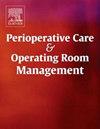运用科克伦Q测验评估护士麻醉师工作习惯量表中单项得分的信息含量,用于提供反馈
IF 1
Q2 Nursing
Perioperative Care and Operating Room Management
Pub Date : 2025-06-27
DOI:10.1016/j.pcorm.2025.100519
引用次数: 0
摘要
背景:对许多医院的麻醉护士进行年度持续专业实践评估(即同行评议)是强制性的。对于这些高风险的评估,工作习惯工具是一种有效的、心理计量学上可靠的工具。我们的研究重点是针对麻醉护士的具体项目反馈,以提高他们的得分。方法回顾性队列研究采用该研究系2015年7月至2024年6月使用量表的全部9个完整学年。167名评分麻醉师对713名护理麻醉师年进行59,863次评估,每次评估有6个非李克特评分项目,评分项目从1到5。结果工作习惯量表具有二元(5 vs≤4)多元(6项)相关(Cronbach alpha 0.96)数组。因此,90% %(53,626/59,863)的6个项目均为5分,或6个项目均低于5分的评估提供了麻醉护士的工作质量信息,但没有潜在有用的特定项目信息用于反馈。对每个护士麻醉师年进行科克伦Q测试,使用剩余的 %的评估来寻找与其他项目有显著差异的项目。调整P <后,护理麻醉师年数为4.6 % (33/713);0.05,代表1.5 %(911/59,863)的评价。4.6 %与名义I型错误率5 %没有差异(P = 0.73)。结论提供单项评分分析最多可使5 %的麻醉护士受益,可能更少。对正在进行的专业实践评价较低的麻醉护士应根据工作习惯进行整体的重点评价。本文章由计算机程序翻译,如有差异,请以英文原文为准。
Evaluation using Cochran’s Q tests of the information content of individual items’ scores in the nurse anesthetist work habits instrument for use in providing feedback
Background
Annual ongoing professional practice evaluation (i.e., peer review) is mandatory for nurse anesthetists at many hospitals. A work habits instrument is a valid and psychometrically reliable tool for these high-stakes assessments. Our study focuses on item-specific feedback for nurse anesthetists to increase their scores.
Methods
The retrospective cohort study used all 9 complete academic years for which the studied department used the scale, July 2015 through June 2024. There were 59,863 evaluations of 713 nurse anesthetist years provided by 167 rating anesthesiologists, each evaluation with 6 non-Likert scored items from one to five.
Results
The work habits instrument functioned as a binary (5 vs ≤4) multivariate (6-item) correlated (Cronbach alpha 0.96) array. Consequently, the 90 % (53,626/59,863) of evaluations with all 6 items five, or all 6 items scored less than five, provided information about the nurse anesthetists' performance quality but no potentially useful item-specific information for feedback. Cochran Q tests were performed for each of the nurse anesthetist years using the remaining 10 % of evaluations to look for items differing significantly from the other items. There were 4.6 % (33/713) of nurse anesthetist years with adjusted P < 0.05, representing 1.5 % (911/59,863) of evaluations. The 4.6 % did not differ from the nominal Type I error rate of 5 % (P = 0.73).
Conclusions
Providing analyses of individual item scores could benefit, at most, 5 % of nurse anesthetists, likely fewer. Nurse anesthetists with low ongoing professional practice evaluations should have focused evaluation wholistically based on work habits.
求助全文
通过发布文献求助,成功后即可免费获取论文全文。
去求助
来源期刊

Perioperative Care and Operating Room Management
Nursing-Medical and Surgical Nursing
CiteScore
1.30
自引率
0.00%
发文量
52
审稿时长
56 days
期刊介绍:
The objective of this new online journal is to serve as a multidisciplinary, peer-reviewed source of information related to the administrative, economic, operational, safety, and quality aspects of the ambulatory and in-patient operating room and interventional procedural processes. The journal will provide high-quality information and research findings on operational and system-based approaches to ensure safe, coordinated, and high-value periprocedural care. With the current focus on value in health care it is essential that there is a venue for researchers to publish articles on quality improvement process initiatives, process flow modeling, information management, efficient design, cost improvement, use of novel technologies, and management.
 求助内容:
求助内容: 应助结果提醒方式:
应助结果提醒方式:


